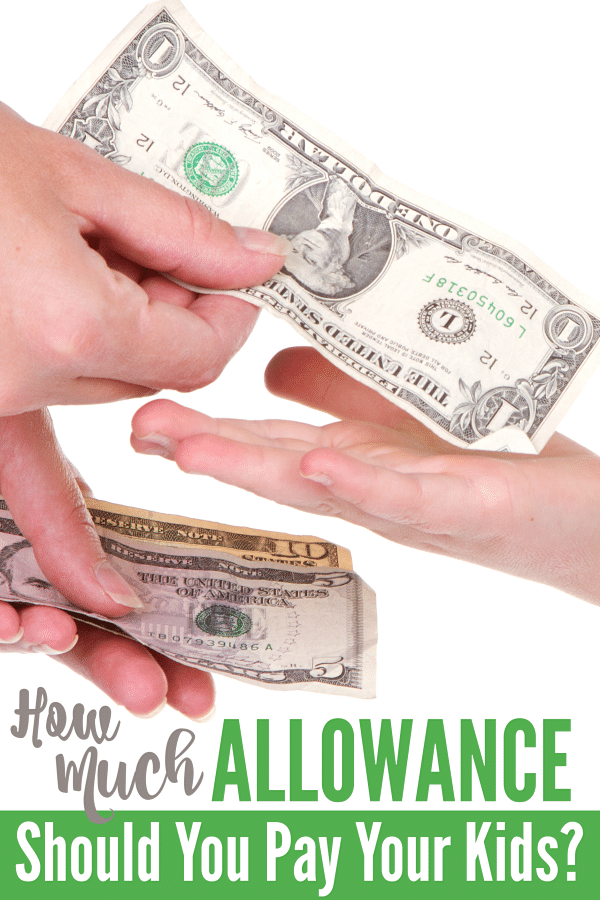One of the questions I get asked the most is “How much allowance should I pay my children?” Money is a private subject for many people so it can be hard to get solid numbers to this question.

Though I will share some actual dollar figures in this post, I’m going to concentrate more on helping YOU decide how much allowance is appropriate for YOUR FAMILY. Each family is different, so whether some parents pay their kids $2 a week while others pay them $20 an hour, neither figure is helpful to you unless it works for you and your family.
Should Kids Receive an Allowance?
The fact that many parents can’t even agree on whether or not kids should get an allowance should indicate how complex this topic is. So, before we dive into determining how much allowance to pay your kids, let’s talk about if you should be paying them at all!
Parents IN FAVOR OF allowances believe that they teach children basic financial lessons. We must work for the money that we need to buy the things that we want.
Since kids’ earning opportunities are limited, if we don’t pay them an allowance, they can’t learn this lesson until much later. If we wait until our kids can work outside the home, we miss years of opportunities to teach them how to save, budget, and differentiate between needs and wants.
The main argument AGAINST allowances is that kids should learn to be responsible and contributing members of the household simply because it is the right thing to do. By paying a child to do things like make his own bed or put her toys away, you’re sending the message that they should be rewarded for not requiring someone else to pick up after them.
A system of financially rewarding kids for meeting minimum requirements of responsibility doesn’t prepare them for the real world where they will be expected to provide value in exchange for payment. Thus, the chores your child receives an allowance for should provide value to the rest of the family.
As you can see, there are compelling points on both sides of the allowance debate. Personally, we opted to pay our kids for chores above and beyond their personal responsibilities.
Our kids are expected to keep their own rooms clean and put their belongings away. They’re also expected to contribute to keeping the house clean and orderly, which includes doing dishes, dusting and vacuuming, and folding laundry.
When we have jobs or projects that are above and beyond normal household maintenance (e.g. spreading mulch, painting a room, reorganizing the garage), we pay the kids for their time and effort on those tasks. In addition, we are open to negotiating additional jobs for pay if one of the kids is working to save for something specific.
This system is one that my husband and I are both comfortable with so it works for our family. In deciding for your own family, take time to think about what lessons you want to teach your kids and structure chores and allowances accordingly.

How Much Allowance?
If you’ve decided that you do want to provide an allowance for your child(ren), you then have to figure out how much is appropriate. Again, it’s best for you to come up with this number rather than adopt a figure that works for someone else.
To help you narrow down an appropriate amount, here are some things to consider:
How Much Can You Afford?
The first very real constraint you should consider is how much allowance you can afford to pay your child. If you make an agreement to pay your child in exchange for their work, then you should be able to follow through and make the payments.
The last thing you want to do when teaching your child about money management is to fail to budget enough to cover your child’s allowance. If you live on a tight budget, you’ll want to avoid open-ended allowances where your child can earn varying amounts depending on the number of chores completed.
Also, if you are going to provide your child with an income, consider whether or not you want to also have your child be responsible for paying her own expenses. For my kids, we cover all of their necessities but they are responsible for paying for entertainment and extras.
How Old Is Your Child?
As your child gets older his responsibilities should increase. Likewise, his allowance should go up as well.
When establishing an allowance, make sure you leave room for growth. Not only will your child likely take on more responsibilities as she gets older, she’ll also become more skilled.
An allowance should match the level and quality of service your child provides. which naturally, will change as your child ages.

How Much Would You Pay Someone Else?
As I already mentioned, I often pay my kids for jobs that I’d otherwise hire out. For example, when my car needs a good deep clean, I’ll offer the job to the kids before taking it to the local car wash where I’d pay $75 for the least expensive detailing option.
Since the kids aren’t professional car detailers and because I provide all of the supplies, I don’t pay them what I’d pay the car wash. However, I do use it as a baseline.
Generally, I start low (about 1/3 of what I’d pay someone else) and let the kids make arguments to negotiate the rate higher. I want them to learn to negotiate and I also want them to learn to deliver on their promises.
If they promise to do all of the same things the car wash would do (vacuum all surfaces, clean windows, treat stains, wash floor mats, etc.) if I agree to a rate of $50, then they’d better deliver on their promise. Otherwise, I might withhold some of their payment for failure to fulfill the requirements of the job.
Likewise, if they OVER deliver, I add a “tip” to the payment. Since I’m trying to prepare them for a life outside of our home, I want them to understand all the nuances of working and earning an income.
Consider the chores you’ve assigned to your child. What would you pay someone else if you had to hire someone to do them?
- Lawn Service = $30 – $80 per visit
- Cleaning Service = $25 – $45 per hour
- Dog Walking = $15 – $20 per walk
- Laundry Services = $1.50 per pound, so an average load of 7 pounds would be $10.50
Of course, when you hire a professional, you get a different level of service than your child will be able to provide. So, don’t try to match those rates, but use them to scale down the rate to one that is reasonable for the work your child can do.
How Much Could Your Child Make Outside of Home?
As your kids get older and opportunities to make money from other sources becomes easier, your rates should become more competitive too. If my daughter can make $15/hour babysitting for the neighbor, I won’t force her to turn down the job to watch her younger sister for $2/hour.
Also, be careful about paying your kids so well that they never want to work outside the home. If the minimum wage is only $7.25 an hour but you pay your kids the equivalent of $10 an hour, they may not be willing to work an entry-level position which is an important stepping stone in entering the workforce.
General Payment Guidelines
While allowance structures are unique to each family, knowing the AVERAGE allowances for each age might help you further narrow down your range. According to a chart in USA Today, here are the average weekly allowances for each age:
- Age 4: $3.76
- Age 5: $4.21
- Age 6: $5.24
- Age 7: $6.69
- Age 8: $7.24
- Age 9: $7.80
- Age 10: $8.10
- Age 11: $9.40
- Age 12: $9.85
- Age 13: $10.79
- Age 14: $12.26
These numbers line up closely with the guidelines suggested on Money Crashers, which is $1 per week per child’s age in years. So, for example, a four-year-old would earn $4 per week and a 10-year-old would earn $10 per week.
Ultimately, it’s up to you whether or not to pay an allowance. If you do, it’s entirely up to your discretion to establish how much to pay.
Hopefully, this article has helped you figure out what will work best for your family. If you have questions that I haven’t yet answered, please share them in the comments.

